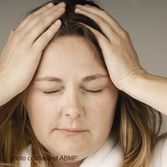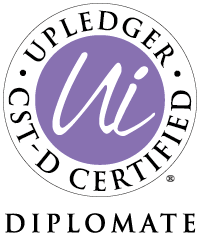 There seems to be more awareness about concussions and traumatic brain injury (TBI) these days. High School sports, accidents and combat zones all involve risk of receiving a concussion or TBI. The good news is that many people are achieving relief from their symptoms and experiencing lasting healing with CranioSacral Therapy. The following is one of my case studies from several years ago highlighting a woman’s recovery from a concussion. Please note: This case study contains technical terms easily understood by a CranioSacral practitioner. For the lay person, don’t worry about understanding all of the anatomy or technique terminology. You will still get the gist of her recovery. Thanks for reading! All the Best to You, MeriJayd Royce is a 54 year old woman who came to see me after slipping and falling on concrete 5 months prior. She had a concussion from the fall with post concussion syndrome also called traumatic brain injury. On her intake form, she wrote that she was experiencing severe crown of head migraines to the point of nausea, intense pain in her right knee and hip, and her hearing was altered. Little noises were very loud and noticeable. Her balance and temperature regulation were off and she wasn’t feeling good. She was often tired, agitated and angry.
Since it was a workman’s compensation case, she had been to multiple doctors, neurologists, and was starting to see the chiropractor. She had to pay out of pocket for some of these sessions, including the sessions with me, in the hopes that she would be compensated by the insurance. On her first session, I evaluated the craniosacral rhythm (CSR) as being weak and not smooth. I was able to do a 10-step protocol and noticed strong restrictions in the falx cerebri and temporal-parietal sutures. In the 10-step protocol, I was able to do the L5-S1 decompression, OCB release and the sphenoid compression-decompression techniques. Overall, I felt each area release about 30-40%. After this session, she reported a reduction in right hip and knee pain. The next session was 7 days later. She reported feeling happier more days during this week. Her right hip and knee were hurting again and she felt some pressure on the top of her head. During the evaluation of CSR at her feet, the CSR had more vitality than last time, but flexion and extension had small amplitude and the CSR felt like it had to work hard to be expressed. The CSR at the shoulders was very hard to feel. I started with diaphragm releases at the thoracic and hyoid. There was some heat and softening. I then moved to the pelvic diaphragm and worked with the sacrum. The sacrum felt glued and jammed into L5. Over time I felt a 70% release into the traction. The sacrum shifted to the left. Royce felt warmth and relaxation in the right knee and hip. Then the sacrum shifted center and began to decompress. She reported feeling a popping at the occiput and an opening in the shoulders. The temporal-parietal suture restrictions changed after using direction of energy, occipital cranial base release and sphenoid work. The sphenoid did not fully decompress until I addressed the hard palate and facial bones. After the second session, she felt her pelvis more open and she was able to do some pilates exercises. She is a pilates instructor. Her right hip felt better but she still felt stiff in the neck with limited range of motion. She was still experiencing anger and emotions not experienced before the accident. In this session, I arced to her left hip and she mentioned that she felt sore there today. As I was working, I felt a connection to the thoracic area. There was a distinct pull in the dural tube at the mid-back. With my hands on her left hip, I maintained some traction and felt some softening. Next I focused in the hyoid and thoracic diaphragm region. As I was working, she felt sensations in her frontal bone. After some time I went to the cranium and found that the left temporal-parietal suture was bulging more than on the right side. I used direction of energy along the suture’s fascia. I did a frontal lift with 50% change. Afterwards, there was an improved CSR. Parietal lift produced 60% release. The Zygomae released on both sides with the right side being more restricted. Work with hard palate found it to be out of sync with the sphenoid. There was also an extension and right torsion lesion in the hard palate. I was able to achieve a hard palate decompression. I ended this session by balancing the TMJ and rocking and gliding the dural tube. Three days later she called me to report that she could move her jaw better with no clicking and she was in a much better mood. She said she was making jokes again and feeling like her old self. We have continued to work together. After this major structural work was done, she experience several energy cyst releases from her pelvis and neck region that were accompanied with Somato-Emotional Release (SER). Specifically, the SER work dealt with anger around her work situation and the way her accident was handled. Her mood has remained improved along with better temperature regulation and her hearing is back to normal. Over the three sessions starting with the 10-step protocol with about 30% improvement in craniosacral motion and vitality, and focusing on sphenoid and hard palate work, I noticed 70-80% improvement in intercranial membrane and cranial bone motion. I addressed the three parts of the compression triad multiple times with increased degrees of improvement resulting in Royce’s return to her happier, pre-accident self. Comments are closed.
|
AuthorHi, I'm MeriJayd O'Connor. I love the human body and I so appreciate our human experience. Come along with me and explore topics that excite me like health, healing, CranioSacral Therapy, gardening, being a Mom, dancing, and good food. Archives
December 2020
Categories
All
|
 RSS Feed
RSS Feed
